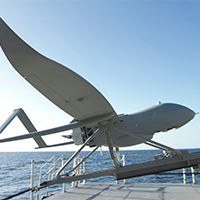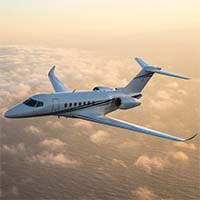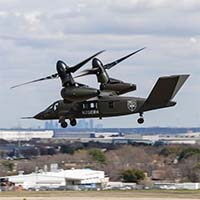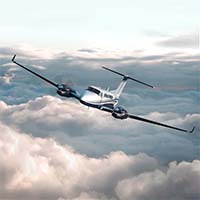TEXTRON THROUGH THE DECADES
Textron started as a small textile company in 1923, when 27-year-old Royal Little founded the Special Yarns Corporation in Boston. Sales that first year were just $75,000. Today that company has grown into a highly successful multi-industry enterprise recognized around the world for our network of powerful brands, world-class processes and talented people.
1920s: The Founding Years
Special Yarns was enjoying success in Massachusetts, and in 1928 a Rhode Island competitor contacted Royal Little, asking him to take over the company. Little agreed to purchase Franklin Rayon Dyeing Company, and for the next two years, he maintained operations in both Massachusetts and Rhode Island.
1930s: Textiles Expansion
In 1930, Little expanded Franklin Rayon’s Providence facility and moved Special Yarns to the new space. This was a banner year for the company; it sold about 4 percent of all rayon yarn sold in the United States. As was the case for many, however, growth slowed tremendously when the Great Depression struck hard in 1932.
Little persevered, improving efficiencies in order to continue to grow the business. His strategy was successful, and in 1936, he made plans to expand the Providence facility using money raised through a small issue of common stock—Little’s first outside financing.
As the decade neared its close, Little changed the name of the company to Atlantic Rayon in 1938 and made his first big expansion step in 1939 by acquiring a portion of an abandoned manufacturing plant in Lowell, Massachusetts. Little used the facility for high-speed throwing of synthetic yarn to produce special effects in material, such as crepe.
With these new operations, Little grew his customer base to nearly 600 in 17 different branches of the rayon industry. The company’s business fell into three main divisions:
- Wholesale distributor for sales agent and rayon yarns
- Skein and packaged dyeing rayon yarns for diversified uses
- Throwing rayon yards for weavers and other trades
The company was profitable when the decade ended.
1940s: The War Years
 As a major producer of parachutes and other textiles used during World War II, the ‘40s ushered in a period of growth and activity for the company, which was then doing business as Atlantic Rayon Corporation.
As a major producer of parachutes and other textiles used during World War II, the ‘40s ushered in a period of growth and activity for the company, which was then doing business as Atlantic Rayon Corporation.
With government contracts dwindling at the end of the war, Little faced the challenge of declining revenue and underutilized production capacity. To meet the challenge, he developed a vertically integrated company that controlled every operational aspect from raw goods processing to distribution and moved quickly from producing parachutes to making lingerie, blouses, bed linens and other consumer goods.
To reflect the new business model and expanded product portfolio, Little chose the name Textron—a combination of "Tex" from textiles and "tron" from synthetics, such as Lustron. The theme of the advertising reflected Little's vision: "From yarn to you, it's Textron all the way."
Marking a major milestone for the company, Textron was listed on the New York Stock Exchange on December 22, 1947.
1950s: The Birth of a Conglomerate
 To offset yet another decline in the demand for textiles in 1952, Little developed a diversification strategy. He planned to maintain textile operations as an earnings base while acquiring non-textile businesses.
To offset yet another decline in the demand for textiles in 1952, Little developed a diversification strategy. He planned to maintain textile operations as an earnings base while acquiring non-textile businesses.
In 1953, Textron purchased its first non-textile business, St. Louis-based Burkart Manufacturing Co. that supplied cushioning materials to the automotive market.
Little acquired companies at a rapid pace and built upon his successes by entering new lines of business with small, incremental investments.
Among the more important businesses added in the 1950s:
- Homelite - retained until 1994
- Camcar - retained until 2006
- CWC – Still a part of Textron today, CWC produces cast iron engine components.
1960s: A Clear Path to the Transportation Industry
 At the end of 1960, Royal Little retired, but not before carving Textron’s imprint into the transportation industry with the purchases of two companies that are still part of Textron today: golf car manufacturer E-Z-GO and Textron Bell Aerospace—which included Bell Helicopter. Buying Bell balanced Textron's earnings base by increasing its government business.
At the end of 1960, Royal Little retired, but not before carving Textron’s imprint into the transportation industry with the purchases of two companies that are still part of Textron today: golf car manufacturer E-Z-GO and Textron Bell Aerospace—which included Bell Helicopter. Buying Bell balanced Textron's earnings base by increasing its government business.
The Bell purchase coincided with the country’s escalated involvement in the Vietnam War. Throughout the decade, the U.S. Army deployed Bell OH-58A and Bell AH-1 Cobra aircraft in combat. The Army embraced the AH-1, also known as the HueyCobra, in part because of its slim profile and lighter weight plexiglass canopy. The aircraft gained prominence during the war years and is considered one of the major U.S. successes in Vietnam. HueyCobras flew more than one million operational miles in Vietnam, and the number of aircraft in service peaked at 1,081.
As Bell Helicopter was making its indelible mark on the military, Little’s successor, Rupert Thompson, and President G. William Miller bade farewell to the textile industry in 1963. Thompson and Miller continued Little’s strategy of acquiring companies, penetrating various consumer markets with the purchase of watchband manufacturer Speidel; Sheaffer Pen; staple and nail gun maker Bostich; and Rhode Island-based silver company Gorham. Throughout this period, Textron was recognized as the pioneer of the conglomerate and one of the most highly diversified corporations in the U.S. In 1967, the Wall Street Journal called Textron "the conglomerate king."
1970s: Survival Amid a Financial Crisis
The post-World War II economic boom came to a crashing halt during a decade marked by an oil crisis, a stock market crash and the demise of Richard Nixon’s presidency. Yet, amid this turmoil, while many conglomerates struggled to maintain positive cash flow, Textron persevered by winning new customers in the aerospace industry and by never wavering from its acquisition strategy.
Bell Helicopter, which relied on the U.S. government for 85 percent of its sales in the ‘60s, developed a broader customer base and enjoyed a surge in profits as a result. By 1975, its sales were evenly divided among three sectors: commercial (both domestic and international), U.S. military and foreign government.
 With its solid footing in the aerospace industry providing financial stability, Textron grew again with the purchase of Jacobsen in 1978. Still a part of Textron today, Jacobsen produces the world’s broadest lines of professional turf maintenance equipment and lawn care machinery.
With its solid footing in the aerospace industry providing financial stability, Textron grew again with the purchase of Jacobsen in 1978. Still a part of Textron today, Jacobsen produces the world’s broadest lines of professional turf maintenance equipment and lawn care machinery.
As the decade drew to a close, Textron experienced changes in leadership. Miller’s tenure ended in 1977 when President Jimmy Carter nominated him to be chairman of the Federal Reserve. Joseph Collinson succeeded him and led the company until he retired in 1979 when Robert Straetz was named chairman and CEO. He and President Beverly Dolan would lead Textron into the reviving economy of the ‘80s.
1980s: Positioned for Growth
In October 1984, Textron emerged newly strengthened for expansion in a rising economy. Straetz and Dolan realized that strategic acquisitions would remain essential for sustained growth. In 1985, Textron acquired Connecticut-based AVCO Corporation, a $2.9 billion conglomerate that played a major role in the Apollo missions of the 1960s and early 1970s. NASA chose AVCO to design and install the heat shield. AVCO pioneered the heat resistant material that charred to form a protective coating and block the heat from penetrating the space capsule. Textron, which nearly doubled in size with this acquisition, transitioned the business to Textron Defense Systems which evolved into today’s Textron Systems Weapons & Sensor Systems. A leader in intelligence-gathering capabilities and advanced protection systems necessary for mission success, Weapons and Sensor Systems continues to provide these heat resistant materials—the thermal protection material of choice for the current NASA Orion Crew Exploration vehicle program.
In 1985, Textron acquired Connecticut-based AVCO Corporation, a $2.9 billion conglomerate that played a major role in the Apollo missions of the 1960s and early 1970s. NASA chose AVCO to design and install the heat shield. AVCO pioneered the heat resistant material that charred to form a protective coating and block the heat from penetrating the space capsule. Textron, which nearly doubled in size with this acquisition, transitioned the business to Textron Defense Systems which evolved into today’s Textron Systems Weapons & Sensor Systems. A leader in intelligence-gathering capabilities and advanced protection systems necessary for mission success, Weapons and Sensor Systems continues to provide these heat resistant materials—the thermal protection material of choice for the current NASA Orion Crew Exploration vehicle program.
In 1986, Textron continued to strengthen its position in the defense industry by forming Textron Marine & Land Systems from a Bell Helicopter business. A manufacturer of an extensive line of military security vehicles, including the COMMANDO™ family of four-wheeled armored vehicles, and marine craft, Textron Marine & Land Systems was chosen to produce the Landing Craft, Air Cushion (LCAC hovercraft) for the U.S. Navy.
1990s: Preparation for the 21st Century
With only a decade left in the 20th century, Textron developed a laser-sharp focus on obtaining 100 percent of its revenues from its core businesses—aircraft, automotive, industrial and finance—and on increasing its international revenue as a source of growth.
 James Hardymon, who was named chairman and CEO in 1992, quickly set out to achieve these goals by acquiring Cessna Aircraft Co. Already popular with pilots worldwide, the U.S. government and foreign militaries, Cessna—as a leader in light and medium-sized commercial business jets—balanced Bell's significant defense-related business activity. Textron’s purchase of Cessna as well as Germany-based Kautex—a global fuel tank and system supplier to the automotive industry—bolstered its core; these businesses’ revenues totaled $3.9 billion.
James Hardymon, who was named chairman and CEO in 1992, quickly set out to achieve these goals by acquiring Cessna Aircraft Co. Already popular with pilots worldwide, the U.S. government and foreign militaries, Cessna—as a leader in light and medium-sized commercial business jets—balanced Bell's significant defense-related business activity. Textron’s purchase of Cessna as well as Germany-based Kautex—a global fuel tank and system supplier to the automotive industry—bolstered its core; these businesses’ revenues totaled $3.9 billion.
To deepen its focus on aircraft, automotive, industrial and finance, Textron decreased its holdings in military contracting, insurance and consumer products, divesting "non-core" businesses that represented $2.8 billion in revenue.
Wall Street reacted well to these activities. Hardymon's concentration on achieving a consistent and strong financial performance resulted in 45 quarters of continuous year-over-year quarterly earnings growth. During his tenure as CEO, the stock price increased from $19.81 per share on January 1, 1992, to $71.69 per share on June 3, 1998, reflecting the market's strong correlation between earnings growth and stock price appreciation.
Having reached the objectives he set at the beginning of the decade, Hardymon retired in 1999. His successor, Lewis Campbell, ushered Textron into the 21st century.
2000-2009: A New Century, A New Vision
Early in the new century’s first decade, Campbell immediately set a new vision for the corporation: to become the premier multi-industry company, recognized for its network of powerful brands, world-class enterprise processes and talented people. This shared vision became a unifying mission for Textron employees worldwide.
Realizing this vision involved a company-wide restructuring program to increase operational efficiency. The transformation included the consolidation of several manufacturing facilities, more unified systems and standards and shared services across the business units. Campbell also championed the idea of moving Textron’s most skilled managers from one business unit to the other, helping to bolster company-wide performance significantly.
 The strategic divestitures and complementary acquisitions that Campbell orchestrated strengthened Textron’s product portfolio. The company’s Fastening & Systems and Fluid & Power businesses were among those Campbell sold, and Overwatch Systems and AAI joined Textron in 2006 and 2007, respectively, and became part of Textron Systems.
The strategic divestitures and complementary acquisitions that Campbell orchestrated strengthened Textron’s product portfolio. The company’s Fastening & Systems and Fluid & Power businesses were among those Campbell sold, and Overwatch Systems and AAI joined Textron in 2006 and 2007, respectively, and became part of Textron Systems.
To help ensure that Textron continued on a positive trajectory, Campbell led a multi-year succession planning process that culminated with his retirement as CEO on December 1, 2009. Scott Donnelly, then-president and COO, succeeded Campbell and became chairman of the board in September 2010.
Early in his tenure, Donnelly faced the challenge of leading Textron through a global economic crisis. During this tumultuous period, he put Textron’s liquidity strategy on a strong path and spearheaded restructuring initiatives and operating improvements across Textron, building upon Campbell’s vision and taking it to the next level. With a steadfast focus on disciplined execution and profitable growth, he significantly increased the company’s pace of new product development and reinvigorated acquisition activities.
2010-2019: Strengthening Textron’s position as an A&D company
Donnelly further penetrated the aviation market with the purchase of Beechcraft in 2014, forming a new business segment called Textron Aviation that includes three powerful brands: Beechcraft, Cessna and Hawker. By joining these three iconic brands, Textron Aviation brings 200+ years of combined aviation experience to the market and an installed customer base of more than 250,000 airplanes worldwide.
 Textron Aviation set upon a path to develop and launch a number of exciting new products while enhancing its customer support programs throughout the decade. It represented the company’s strategy of steady growth and the innovation, creativity and dedication of our people. In 2015, Textron Aviation celebrated the certification and first delivery of the Cessna Citation Latitude, a new, midsize aircraft that went from initial concept to delivery in just four years. The Latitude would go on to become the world’s best-selling aircraft in its class. Meanwhile, Textron Aviation was simultaneously developing its newest aircraft, the Cessna Citation Longitude, its super-midsize jet, which was certified and delivered to customers in 2019.
Textron Aviation set upon a path to develop and launch a number of exciting new products while enhancing its customer support programs throughout the decade. It represented the company’s strategy of steady growth and the innovation, creativity and dedication of our people. In 2015, Textron Aviation celebrated the certification and first delivery of the Cessna Citation Latitude, a new, midsize aircraft that went from initial concept to delivery in just four years. The Latitude would go on to become the world’s best-selling aircraft in its class. Meanwhile, Textron Aviation was simultaneously developing its newest aircraft, the Cessna Citation Longitude, its super-midsize jet, which was certified and delivered to customers in 2019.
Bell introduced its offering for the U.S. Army’s Joint Multi Role/Future Vertical Lift technology demonstrator program with the Bell V-280 Valor, its third-generation tiltrotor and achieved its first flight in 2018. By the beginning of the new decade, the Pentagon had announced the Bell V-280 Valor was selected to compete in the next round of the Future Long-Range Assault Aircraft (FLRAA) program.
![]() In January 2019, Textron Specialized Vehicles (TSV) announced an exciting agreement with Bass Pro Shops under which TSV would design and manufacture a new line of high-performance side-by-sides and ATVs to be branded as Tracker Off Road and distributed by Bass Pro Shops, Cabela’s and independent Tracker Marine dealers. By the end of 2019, Tracker Off Road vehicles were being offered at more than 230 retailers, with plans to add more retailers in the future.
In January 2019, Textron Specialized Vehicles (TSV) announced an exciting agreement with Bass Pro Shops under which TSV would design and manufacture a new line of high-performance side-by-sides and ATVs to be branded as Tracker Off Road and distributed by Bass Pro Shops, Cabela’s and independent Tracker Marine dealers. By the end of 2019, Tracker Off Road vehicles were being offered at more than 230 retailers, with plans to add more retailers in the future.
2020 and Beyond: New Opportunities for Growth

In December 2022, Bell was awarded the development contract for the U.S. Army’s Future Long-Range Assault Aircraft (FLRAA) program. We were honored the Army selected the Bell V-280 Valor tiltrotor to modernize its Air Assault fleet and we look forward to delivering this transformational aircraft to the warfighters. This award builds on a decade of the V-280 Valor’s progress through design, manufacturing, and thorough testing to demonstrate that this aircraft will deliver on the FLRAA program requirements.
Bell is also competing for the U.S. Army’s Future Attack Reconnaissance Aircraft (FARA) program with its Bell 360 Invictus aircraft. Bell was one of two rotorcraft downselected for the FARA program in March 2020 and has since built the prototype and is currently conducting airworthiness testing and ground runs.
 Textron Aviation continued to introduce new products to its portfolio. In 2022, Textron Aviation celebrated the certification and first delivery of the Cessna SkyCourier, its new clean-sheet aircraft, to launch customer FedEx Express. In just the first three years of the decade, Textron Aviation launched its Citation M2 Gen2, Citation XLS Gen2 and CJ4 Gen2 aircraft, representing the next generation of our popular models, while also bringing out the Beechcraft King Air 360, its updated flagship turboprop, and the King Air 260, which builds on the platform’s rich history of rugged reliability and versatility. Textron Aviation also introduced its Beechcraft Denali, a new single-engine turboprop currently in flight test program.
Textron Aviation continued to introduce new products to its portfolio. In 2022, Textron Aviation celebrated the certification and first delivery of the Cessna SkyCourier, its new clean-sheet aircraft, to launch customer FedEx Express. In just the first three years of the decade, Textron Aviation launched its Citation M2 Gen2, Citation XLS Gen2 and CJ4 Gen2 aircraft, representing the next generation of our popular models, while also bringing out the Beechcraft King Air 360, its updated flagship turboprop, and the King Air 260, which builds on the platform’s rich history of rugged reliability and versatility. Textron Aviation also introduced its Beechcraft Denali, a new single-engine turboprop currently in flight test program.
Textron Systems advanced its weapons programs with two contract awards based on its new anti-vehicle munition system that fulfills the U.S. Army’s directive for next-generation technology in this area: the XM204 Top Attack Munition, an anti-vehicle terrain shaping system, and a second award that adds mission planning tools and a remote-control station that enables constant soldier-in-the-loop control.